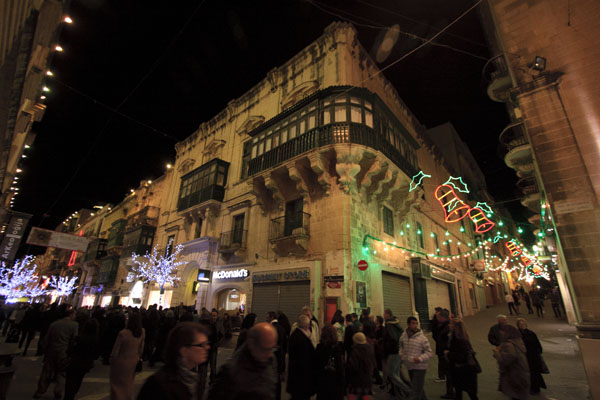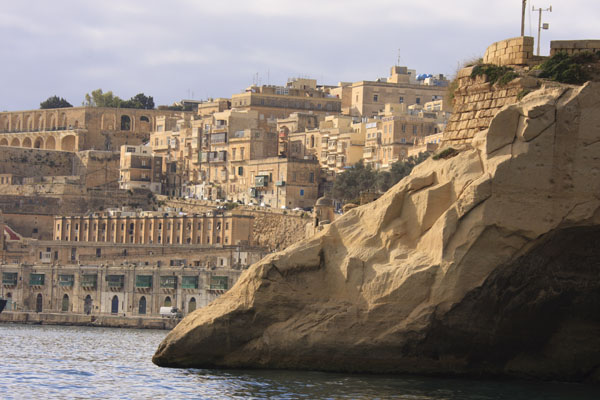Ok, so I’ve been working on this post for WAY too long. I’m going to finish it and then post pictures I’m sure most of you would prefer to see … Lily Anna. First, on with Malta. Over the holidays, Anna and I decided to go to the historic southern European country of Malta. This tiny republic has played a very historic role for several millennia . In western culture (particularly Christian), Malta is the (in)famous site where St. Paul was shipwrecked. That is, at least according to the Book of Acts 27-28 in the bible. I doubt the ships looked the same in St Paul’s day, but they are quite colorful these days. However, it is possible, since it is said the design of the boats can be attributed to the Phoenicians who arrive on the island around 800 BCE.
These boats are from the charming fishing village of Marsaxlokk. We stopped for a while for a delicious fish filled lunch.
In more modern times, Marsaxlokk Bay was made famous with the Malta Conference of 1989. It was here that US President George H.W. Bush and USSR Chairman Mikhail Gorbachev met in December of that year to declare an end to the Cold War. At the conference, Mr. Gorbachev said “The world is leaving one epoch and entering another. We are at the beginning of a long road to a lasting, peaceful era. The threat of force, mistrust, psychological and ideological struggle should all be things of the past.” Sadly, that has not proven to be the case … yet. Perhaps soon we will enter into a period of peace. Maybe even one that can be long lasting. I know we can all agree that the world would be a much better place, if that were the case. Below are more boats from the village. The conference was conducted on boats that are much larger. However, because a large storm hit early December 1989, and the US ship that was to host the conference was moored in relatively unprotected waters, the conference was nicknamed the “Seasick Summit.” Fortunately, they two leaders were able to go aboard the Soviet ship and the conference was able to progress.
The architecture was quite unusual too. Nearly all the house had a enclosed wooden balcony. Apparently, they are remnants of British influence in the 18th century. As with many things in Malta, they also have an Arab/North Africa influence with possible roots in muxrabija windows. They were built to provide a secluded vantage point for women and slaves to see the street without being seen themselves.
The Maltese language also has strong influences from the Arabic language, which is logical due to it’s proximity to North Africa. However, since the island was ruled by the Brits for 150 years, nearly everyone can speak English. But, before we talk about modern history, Malta has some remnants of ancient civilization. In fact, they have temples that are 4-6,000 years old. in 2009, they were covered in an attempt to protect them from the elements. This is the Ħaġar Qim site built 3600 – 3200 BCE. For context, the Great Sphinx and the Pyramids of Giza in Egypt are thought to have been built around 2600 – 2500 BCE, a thousand years later.
A limited view of the stone structures. Unfortunately, the protective tent precludes better perspective of the site, but the complexity is quite impressive. 
The statuette below was found in the Ħaġar Qim temple and is called the Venus of Malta. She is from 3600 – 2500 BCE and is made of fired clay. As you can see, her proportions are very lifelike. Although the statuette is quite small, it is quite intricately crafted. Today, she is housed in the National Museum of Archaeology in Valletta.
Another impressive artifact found at the museum is the “Sleeping Lady.” She was found at the Ħal Saflieni Hypogeum, from the same era and is very small, measuring only 12cm. There is debate as to why she is in repose… Could it be the innocence of restful sleep or the eternal kind? Was she a priestess or merely a beautiful, voluptuous woman? We’ll never know… 
This is the lower site, Mnajdra, which was possibly used for astrological work. Both sites are among the most ancient religious sites in the world and have UNESCO status. 
We happened to be in Valletta for their New Year’s celebration. Although it was small compared to say Amsterdam or New York, it was huge for a small country like Malta. As you can see, the buildings were well lit and decorated. Since the island is overwhelmingly Catholic, the Christmas decorations were ubiquitous. 
Although not as renowned as Murano glass in Venice, the Maltese glass company Mdina is quite good.
For some reason, my eye is often drawn to groups of police.
The main event for the night was a concert by Airport Impressions. Malta has a thriving music scene, and this band won the Best Band honors last year. 
This is another Maltese performer … although we would say slightly less talented but very enthusiastic.
Happy New Year!
Another oddity of Maltese culture was the dress. Particularly for young girls. For a seemingly conservative Catholic country, the dresses were impossibly short and heels ungainly high. At least on New Year’s eve. As an aside to highlight the conservative nature of the society … Malta passed a law (after a 53% referendum approving the change) only last year to legalize divorce. Now, only the Philippines and the Vatican City prohibit divorce. Here is a photo from the day after (bus ride of shame?) to give you an idea of what the dresses and heels looked like. We watched many a teenage girl struggle with the cobblestone streets and stairs that are omnipresent.
We also took a boat tour to see the beautiful architecture of the island. As you can see the rock and quarried stone have a natural golden beauty. 
Much of the beautiful baroque construction came from the Knights Hospitaller (or the Order of the Knights of Saint John). They came to the island in 1530. Their story is an interesting one … at least for the first 50 years. The knights had previously been on the island of Rhodes, but as a result of their ongoing “Crusades” AKA their religious wars with the Ottoman Empire, they were defeated in 1522. After wandering looking for a home throughout Europe, the Knights were given the island of Malta by the Holy Roman Emperor Charles V in 1530. His annual payment (and subsequent Spanish kings’) was one falcon. Side note — These Maltese Falcons were the historic inspiration for the eponymous book by Dashiell Hammett and the classic 1941 Humphrey Bogart film. Once the Knights arrived on the island, they set about improving the infrastructure and re-enforcing the defenses. Plus, as their name suggests, they also improved the hospitals. All these changes proved essential. In 1565, under the reign of Sulieman the Magnificent, the Ottoman’s decided to strike back. After seemingly endless victories, the Ottoman’s appeared invincible to the Europeans. So, when a force of around 48,000 laid siege to Malta in the summer of 1565, the Knights and their local hosts were faced with difficult odds of survival. However, through the excellent leadership of the Frenchman Jean Parisot de Valette and some misdirection, the knights and their force of about 6,000 were able to turn back the Ottoman’s superior force. This event was celebrated throughout Europe and broke the Ottoman illusion of invincibility. Two centuries after the battle, even Voltaire cited the event when he said “nothing is better known than the siege of Malta.”
After the successful defense of the island, the Knights began construction on the beautiful city of Valetta … to honor their Grand Master who led the defense. The order is independent of the church, but the Grand Master is equivalent to a junior cardinal in the church. Today, the Sovereign Military Order of Malta is headquartered in Rome to focus on hospital and humanitarian aid as an order of the Catholic Church and has international sovereignty, including Observer status in the United Nations.
In 1798, Napoleon I stopped in Malta on his way down to Egypt. Since a large number of the Knights were French or descendants of French citizens, they welcomed the French Army. Although he only stayed 2 days in June, Napoleon I had a lasting influence. Not the least of which because he claimed the island for France. Since the Order forbade the knights from taking up arms against other Christians, the protectors of the island were helpless to stop the French take-over. After the French army left, only 3,000 troops remained on the island. 
Unfortunately, the French garrison’s behavior galvanized dislike for the French (i.e. looting the churches to fund Napoleon’s wars … in a fiercely proud Catholic country, that was an ill advised action). So, in 1800 the locals were aided by the United Kingdom, Kingdom of Sicily and Kingdom of Naples. Their support defeated the French on the island and the Maltese leaders turned to Great Britain to protect the island. They did so and as part of the Treaty of Paris in 1814, Malta became part of the United Kingdom. The Brits provided improvements and the opening of the Suez Canal in the mid-nineteenth century further enhanced Malta’s strategic location. As you can see below, the Victoria Gate celebrated the Queen at the end of the 19th century. 
The Maltese people provided a pivotal role in both World Wars. In fact, the people of Malta showed such bravery that the Island was awarded the King George’s Cross for bravery during the siege of Malta in 1942. The Cross remains on the flag today. In 1964, a negotiated independence from the UK was achieved, with Queen Elizabeth II remaining as head of state. 10 years later, the island declared itself a republic with an elected president as the head of state, but still remained a part of the commonwealth. In 1980, the Republic of Malta adopted a stance of neutrality. This enabled that Seasick Summit in 1989 to negotiate the end of the Cold War. Finally in 1990, the long process of joining the European Union began. The final phase of which was the inclusion in the Euro Zone in 2008.
Today, Malta enjoys its continued unique status as one of the southernmost countries in Europe. The photo below shows a modern ferry that operates between Malta and Sicily. On its delivery run in 2010 from Australia, the crew ran across pirate skiffs off the coast of Sicily. Fortunately, the ship can travel up to 42 knots and was able to outrun the pirates.
Sailors and military members from around the world share some things in common. There are long stretches of relative boredom. These are Russian sailors who were in port at Valetta. I suspect it wasn’t quite the same in 1989.
Here are those glass globes again.
As witness to the religious nature of the Knights Hospitaller in the baroque era, the St. John’s Co-cathedral is absolutely stunning (it shares cathedral status with the Cathedral of St Paul in Mdina). It was consecrated in 1578. Each wing or chapel is dedicated to a different Langue (tongue) to represent the various origins of the knights. There are eight in total. One of the treasures is an exquisite painting by Caravaggio. In his typical fashion, the very moment of the beheading of St John is captured with breath-taking poignancy. Every time I see one of his master pieces, I’m utterly astounded. He was truly a master and certainly one of my favorite artists. As for the man himself … well, it sounds like he was a bit of a scoundrel (at least according to history … which is often far from accurate). Caravaggio arrive on Malta in 1607 as a skilled 36 year old artist … with a price on his head. He had apparently killed a man the year before and was a wanted man. In spite of this, the Grand Master made Caravaggio a knight and commissioned him to paint St John. Unfortunately, soon after the masterpiece was completed, the artist injured another knight and was thrown into prison. He was able to escape, but was stripped of his knighthood and called a “foul and rotten member.” Although he managed to escape the island his freedom was short lived. In Naples he was seriously injured during an attempt on his life. Susequently, he painted an image with his own head on a platter. Shortly there after, the job was completed. In 1610, Caravaggio was killed in suspect circumstances. Although it has never been proven, some suspect that the Knights Hospitaller of Malta finally finished the job…. We will never know.
This is the memorial stone on a tomb of a French knight. The rough translation of the Latin inscription is … “Ye who tread on me will soon be trodden upon.” True.
So, that completes our time on Malta. It was a great place and our first trip without the little man (my mother was kind enough to come watch him).
Next up will be out of chronological order … I’ll post some images of Lily who was born this week. 🙂
Until then…
–Jim



















about the english toutrsis: i really like hearing them talking in their accent, and just love looking at their ****** expression as they speak trying to articulate their words another thing which fazes me about the british toutrsis (and most other toutrsis for that matter) is their obsession of taking photographs of our old buses are they really that interesting?!?british toutrsis also have a knack of turning into red tomatoes after a day at the beach this is one of the things which helps me identify these persons as toutrsis )))british toutrsis are also the most generous when it comes to tips )) the older ones are just adorable they are easy to please, say a lot of thankyou’s and please and like to converse with the locals and are really pleasant (compared to italian toutrsis especially) this is coming from a person who worked in a hotel serving toutrsis, so i know what i am saying ))i think this comes from the fact that british toutrsis still view malta as a far british outpost, a place where they go for holidays after all, malta was used as such by the british when it was still a colony more than 40 years ago. also the fact that many maltese speak english may be a factor but well, i am not one to talk, as i am not english!!!now about the germans: i have met much more german students than older ones, as many german students come to learn english in malta these student-toutrsis are just like the other student-toutrsis: they like to party a lot, shopping, and going to the beach not much time to visit historical places, and not much time either to talk with the locals, so there is not much i can say about them!!!hope this helped please take no offense with what i said i just say things as they come . and hope you’ll keep coming to malta you know we always welcome you with open arms